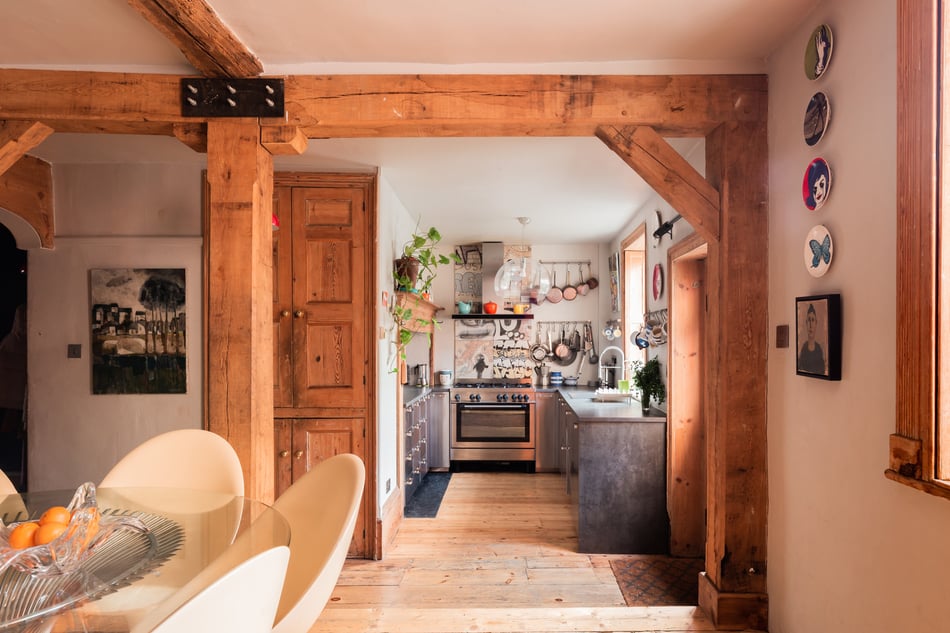
Taking pride of place at the start of one of the most characterful medieval streets in Kent is this striking three-storied Grade-II-listed townhouse. The ground floor has been modernised to create a series of warm, convivial spaces linked together by a playful colour palette and timber detailing. Upstairs, five double bedrooms are tucked away beneath the double-gable roof, and the handsome weatherboard rear façade looks onto a flourishing courtyard garden. Abbey Street runs north from the historic centre of Faversham, a market town awash with antique stores, boutiques, cafés and restaurants. Nearby Canterbury is a short drive away, and Faversham Station, a 10-minute walk, runs direct services to London St Pancras in under 70 minutes.
Setting the scene
Faversham is described in the 2013 edition of Pevsner as “one of the most rewarding towns in the county, though pleasurable in many small ways rather than for spectacular beauties.” A well-preserved collection of these ‘small ways’ can be found on Abbey Street, one of the finest medieval streets in southeast England and a nationally important streetscape of predominantly timber-framed historic buildings. Designed as a grand approach to the now-ruined Abbey, the street runs parallel to Faversham Creek, historically the northern gateway to the Cinque Ports and an important harbour for boats and ships for over 1,500 years. For more information, please see the History section.
Grand tour
This 15th-century home, re-fronted in the 18th century, retains its characteristic overhanging jettying, including a substantial bressummer that spans across the full width of what was once one townhouse. After separation into two separate dwellings, the comely rendered façade of the house is asymmetrically mirrored by its neighbour, with both doorways side by side at its centre. The house is topped with a terracotta-tiled roof typical of both the county and Abbey Street in particular. The six-panel front door, flanked by fluted pilasters, leads to a broad and generous hallway. Wide floorboards continue into the living room, which is lit by an original sash window set within a curved bay. Opposite, a wood burner sits in a brick-backed fireplace. High timber skirtings and a delicate dado rail add an elegant flourish to the space.
The kitchen at the rear of the house is well-designed for entertaining, with its direct connections to an open dining space and to the sunny courtyard garden beyond. Contemporary steel-faced kitchen units flank a five-burner gas range set at the end of the galley, and a large steel sink is set before a grand sash window framed by warm timber shutters. The dining area has high-level shelving for displaying trinkets and books, a centrally-placed wood burner and views out over the garden.
Downstairs, a generous cellar has been adapted for use as a home office, lit by a high-level window to the rear of the house.
Original floorboards lend the first-floor landing a glowing warmth that continues into the secondary living room, a well-proportioned space centred around a Georgian fireplace flanked by inset storage.
Across the hall, the principal bedroom is a calm retreat, painted in Farrow and Ball ‘Pitch Black’, a dramatic shade of black that makes for a satisfying counterpoint to the smooth timber floors and beams. The accompanying en suite has been finished with neutral tiling.
A further bedroom, currently used as an office, sits alongside a bright bathroom where a freestanding bath is placed in front of a wide tripartite casement window. A large walk-in shower runs across the back wall and the walls are painted in Farrow and Ball’s softly toned ‘Cornforth White’.
Timber stairs curve up to the top floor, where the late medieval character of the building is immediately apparent; each of the three bedrooms is set within the steeply pitched roofs, with a sense of seclusion and peace throughout.
Great outdoors
The rear of the house is particularly handsome in a singularly Kentish manner. Maroon brickwork wraps the ground floor, a rugged base for the first and second-floor façades clad in smart shiplap boarding that accentuates the whimsical and medieval forms of the house.
Bordered on three sides by charming patchwork brick walls, the garden has a secluded feel. The garden has a considered structure: a brick patio with a built-in barbecue is connected to a broad parquet brick pathway which cuts along the centre to a secluded terrace at the rear. Dense perennial planting creates a riot of colour and form – eucalyptus and date palms, smoke bushes and japonica jostle for pride of place and form soft, generous borders which provide interest year-round.
Out and about
Faversham is well known for its weekly local food market, monthly brocante – the largest town centre antiques market in the UK – and a host of restaurants and cafés. Faversham Creek is host to the famed fish market ‘Hermans Plaice’, Creek Creative Studios, independent antique shops and waterside pizzeria Papa Bianco.
The Phoenix Tavern and Sun Inn (which date back to the 14th century) are well-regarded pubs in the area, both serving gastro-menus. Shepherd Neame Brewery is the oldest brewery in the country and offers regular tours. There is also an independent cinema which dates back to the 1930s. Faversham is home to a thriving live music scene, an annual hop festival and a literature festival, whilst nearby Whitstable hosts a contemporary art biennial and annual oyster festival.
A little further afield is the revered Macknade food hall and café, which dates from 1847 and offers locally sourced produce. A ten-minute drive away, the rightly revered Michelin-starred pub The Sportsman offers refined dining at the edge of Seasalter. The area is renowned for its viticulture, and Gusbourne and Chapel Down make locally produced white and sparkling English wines and lead wine tours year-round. Kent is awash with walking routes through its abundant woodlands, marshes, shoreline and historic estates. Come summer, the county lives up to its name as the ‘Garden of England’ is resplendent with cherries, strawberries, and later on, apples and pears.
Abbey Street is a 10-minute walk from Faversham Station, which offers regular, direct services to Canterbury in 10 minutes, the Kent coastline and London St Pancras in 70 minutes.
Additional information about tenure: this house has a flying freehold
Council Tax Band: F
History
Abbey Street began as a 12th-century highway laid out as a grand approach to Faversham Abbey, which had survived Henry VII’s dissolution of the monasteries. The area was quickly populated by merchants, craftsmen and seamen whose living was tied to the Creek that runs parallel.
Towards the end of the 19th century, middle-class residents developed and retired to new houses outside of the town centre, and many of the properties were tenanted. By the turn of the century, the street was in a state of disrepair after years of neglect from Landlords and the post-war penchant for new technologies and modern ways of living jeopardised the unique streetscape.
Fortunately, the Society for the Protection of Ancient Buildings intervened and pioneered a scheme jointly launched with the Faversham Borough Council in the late 1950s. Individually, none of the houses were of sufficient importance to receive grants for their own conservation, however, the case was made for their national importance as a group, and the first ‘town scheme’ was started. Under slum-clearance powers, the majority were bought by the council and sold to owners who covenanted with the council to restore them under the supervision of a historic building architect, a process which ensured their considerate conservation.
During this renovation, Abbey Street was planted with trees and became the first street in the UK to be narrowed rather than widened to reduce traffic nuisance and retain its medieval character.
Interested? Let’s talk
Related Listings
- Coastal Collective: five beautiful boltholes a stone’s throw from ocean sprayHomes
- Great and Small: five exceptional cottages worth dreaming aboutHomes
- Historic Heights: six distinctly noteworthy homes, Grade II*-listed and aboveHomes
- A Private View: a self-taught vintage cognoscente shares the lessons learnt during her first renovationHomes / Interiors
- A Private View: the artful home of Robin Welch, the celebrated ceramicist who broke the mouldHomes / Interiors

